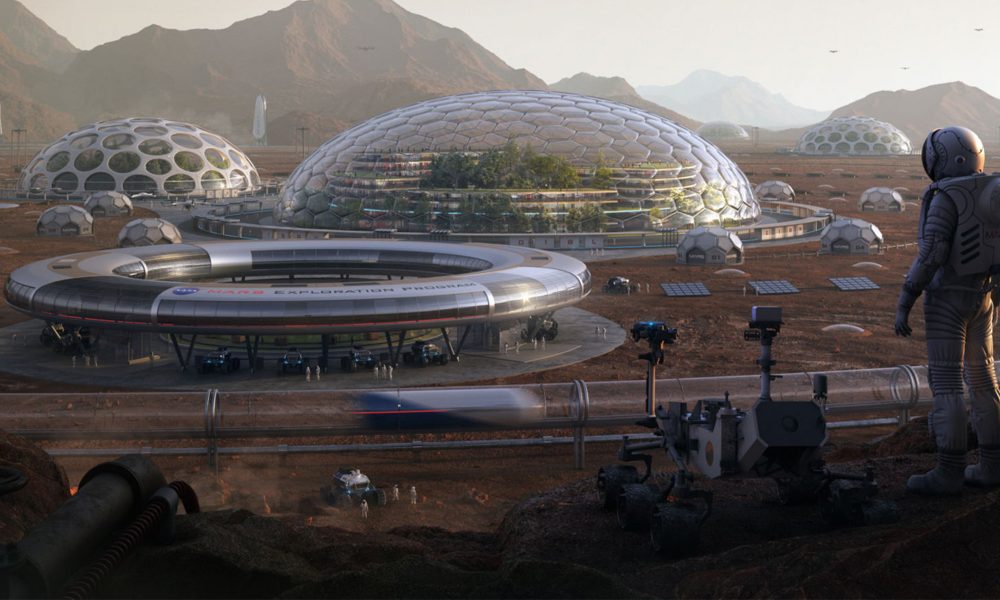Long-term space exploration will require infrastructure that does not yet exist: buildings, sleeping quarters, launch pads, and so on. So where can we find the necessary building materials, when they are too bulky or too heavy to carry on a spacecraft? Researchers at the University of Delaware estimate that it will be necessary to design the cement somewhere other than on Earth.
The research team, led by Norman Wagner, chair of the university’s chair for biomolecular and chemical engineering, is trying to develop ways to use clay-like materials, which end up in the top layer of lunar or Martian soil, as a base for creating this extraterrestrial cement.
To achieve their goal, the specialists will need a binding agent to “glue” basic extraterrestrial materials. One of the criteria for this extraterrestrial cement is that it must be strong and durable enough for launch pads to protect human rockets from stones, dust, and other debris thrown during missile landings and operations.
Most traditional building materials, such as cement made here, are not suitable for spatial conditions.
Wagner and colleagues successfully converted simulated lunar and Martian soil samples into geopolymer cement, which is a good alternative to conventional cement. The research team also created a framework for comparing different types of geopolymer cements and their properties.
The results of their work are presented in Advances in space research.
Different types of cement
Geopolymer cements are inorganic polymers composed of aluminum silicate minerals found in clays widely distributed, both in North America and Africa, among others. When mixed with a solvent that has a high enough pH, such as sodium silicate, the clay can dissolve, allowing the aluminum and silicon inside to react with other chemicals, other materials and form new structures, such as cement.
The soil on the Moon and Mars contains clay as well.
Also according to Mr. Wagner, the process carried out by the researchers, particularly during their tests of simulating extraterrestrial soils, is particularly complex. Especially if it is necessary to determine which combinations of substances and solvents can work.
“It’s not a trivial thing,” he says. “You cannot take any clay and expect it to work. There are conditions to be respected, you must worry about chemical relations.”
The researchers mixed different types of soil with sodium silicate, then placed the geopolymer mixture into ice-cube-like molds, before waiting for the reaction to occur. After seven days of waiting, they measured the volume and weight of each cube before crushing it to analyze the material’s behavior under pressure.
The scientists particularly wanted to know if slight differences in chemical reactions between the simulated soils affected the materials’ resistance.
“When a rocket takes off, a lot of force is exerted down on the launch pad, and the cement has to hold up, so the compressive strength of the material becomes an important feature,” Wagner said. “At least on Earth, we’ve been able to turn materials into tiny cubes that have the compressive strength needed to get the job done.”
The researchers also calculated how much Earth material the astronauts would need to take with them to build a landing pad on the Moon or Mars. The missiles seem to have enough space to carry all this, and we are talking about hundreds or even thousands of kilograms.
space simulation
The research team also subjected their samples to different environmental conditions present in space, including a vacuum and low and then high temperatures.
Under the vacuum of space, some materials formed cement, while others caused only a partial chemical reaction. In general, however, the compressive strength of geopolymer cements decreased in vacuum compared to samples stored under the atmosphere and at normal temperature. This leads to new aspects to be taken into account, depending on the usefulness of the materials.
“There will be limitations, depending on whether we need to create these materials in a pressurized environment, to make sure that the reaction produces the strongest substance, or whether we can dump it under vacuum, which is the natural environment. The Moon or Mars, and they come up with something satisfying” , says Jennifer Mills, who was involved in the work.
On the other hand, at temperatures around minus 80°C, the geopolymer materials did not react at all.
“This tells us we’re going to need to use something to speed up the reaction that we see at room temperature,” Mills says. “Maybe the geopolymers need to be heated, or maybe we need to add something else to the mix to catalyze the reaction, given that they are used in different environments.”
When Amazon doesn’t offer…
Ultimately, these experiments make it possible to determine what might be used for future expeditions aimed at exploring worlds other than our own. Since it is impossible to get supplies quickly, once you leave the launch pad, it is best to know the interactions of extraterrestrial materials among themselves if you plan to build structures elsewhere in the solar system.
The researchers also say that this work could lead to the development and use of more efficient, less polluting cements here. Among other things, geopolymer cements require less water than conventional cements, especially since water is not consumed in the reaction. The water can then be harvested and reused, which is an advantage in environments with water scarcity, whether it is an arid region or a deep space.
Don’t miss any of our content
Encourage Octopus.ca

“Hardcore beer fanatic. Falls down a lot. Professional coffee fan. Music ninja.”







More Stories
A documentary film denouncing the destruction of the planet
Robert Sovi Institute for Occupational Health and Safety Research
Starliner's first manned flight in May